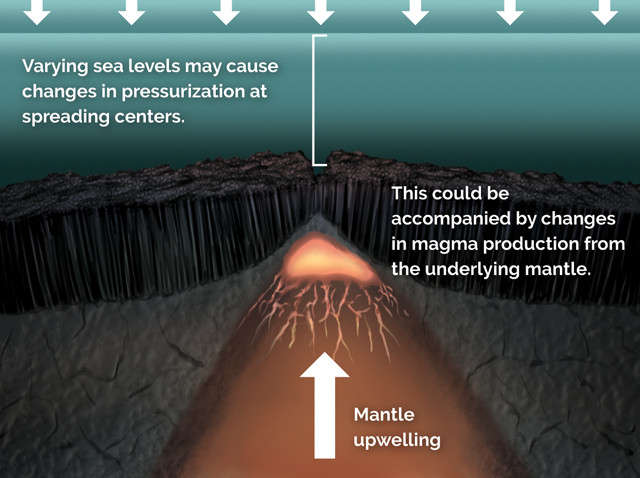
by Mary Caperton Morton Wednesday, March 29, 2017

Sea-level changes related to glacial and interglacial cycles may affect magma production at mid-ocean spreading ridges. Credit: K. Cantner, AGI, and Julia Rosen.
Eruptions from seafloor volcanoes and cycles of global glaciations may seem unrelated, but new research suggests otherwise, indicating that pulses of volcanism at mid-ocean ridges might have influenced glacial and interglacial periods during the latter half of the Pleistocene.
“Climate scientists have traditionally focused on terrestrial contributors to the carbon cycle when studying the timing of glacial and interglacial cycles, but seafloor volcanism may also play an important role,” says Maya Tolstoy, a marine geophysicist at Columbia University’s Lamont-Doherty Earth Observatory who wasn’t involved in the new work. Mid-ocean ridge volcanism has long been thought of as a steady-state process, Tolstoy says, but that view is changing, with researchers observing pulses of increased and decreased volcanic activity that seem to match up with interglacial and glacial cycles.
How these processes could be related has to do with the timing of eruptions and the amount of melt produced, as related to sea-level changes, Tolstoy says. During interglacial periods when sea levels are higher, there is increased pressure from seawater on the seafloor, which could suppress magma production at spreading ridges; conversely, during glacial periods when lower sea levels prevail, decreased pressure on the seafloor could enable decompression melting in the underlying mantle and lead to increased eruptive activity at ridges.
Episodes of increased seafloor volcanism during a glacial period would add carbon dioxide to the oceans and atmosphere, which would in turn, seemingly, contribute to warming and help drive the planet back toward deglaciation. But the effects of sea level-induced increases in volcanism on glacial-interglacial cycling depend on when the resulting burst of carbon dioxide is released, says Peter Huybers, a climate scientist at Harvard and co-author of the new study, published in Earth and Planetary Science Letters. This is because it takes a while — perhaps tens of thousands of years — for the excess melt and carbon dioxide triggered by falling sea levels to make their way from the mantle to the surface at mid-ocean ridges.
“The novel contribution of our study is [characterizing] this delay,” Huybers says. “The travel time of melt through the mantle is highly uncertain, but a plausible number is about one meter per year.” With the sources of melt beneath mid-ocean ridges thought to be about 50 kilometers below the ocean floor, it would take about 50,000 years at this rate for carbon dioxide to migrate to the surface and exert an influence on glacial cycles, he says.
When this delay is factored into a simple feedback model developed by Huybers and co-author Charles Langmuir, also of Harvard, the net effect is that mantle decompression, which normally produces a negative feedback on glaciation, becomes a positive feedback because of its slow response time, thus contributing to a longer glacial period. And the reverse is also potentially true for rising sea levels shutting off excess mantle melting and carbon dioxide production. When plotted alongside the pattern of alternating glacial and interglacial periods in the latter part of the Pleistocene, the influence of these delays appears to help explain why glacial cycles extended from 40,000-year intervals to 100,000-year intervals in the Middle Pleistocene.
The main drivers of these climate cycles are thought to be long-term changes in Earth’s orbit, orientation and tilt. But “there’s an increased likelihood of having 100,000-year glacial cycles” when the delayed effects of mid-ocean ridge volcanism are factored into the model, Huybers says.
The simplified models in the new study are a good start for investigating links between seafloor volcanism and glacial pacing, but more work is needed to assess some of the assumptions made by Huybers and Langmuir, Tolstoy says. “There are significant uncertainties here, particularly with our understanding of how quickly melt migrates through the mantle,” she says.
Answers may come from studies of melt production rates and patterns at mid-ocean spreading ridges, as well as a better understanding of how seafloor volcanism contributes to the oceanic carbon cycle, Tolstoy says. For example, it’s not well understood whether hydrothermal vents are net carbon sinks or sources. Additional seafloor instrumentation, as well as global seismic networks, will help, she says, but the task is daunting. “It’s good they started simple. The next step will be to complicate it with a lot more data.”
© 2008-2021. All rights reserved. Any copying, redistribution or retransmission of any of the contents of this service without the expressed written permission of the American Geosciences Institute is expressly prohibited. Click here for all copyright requests.